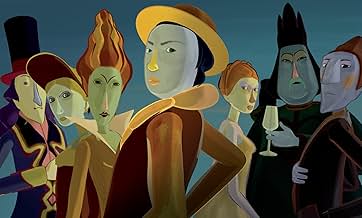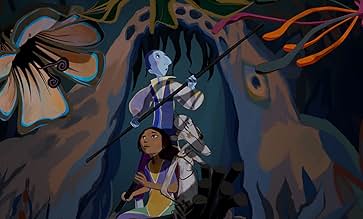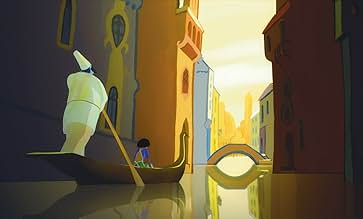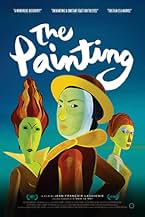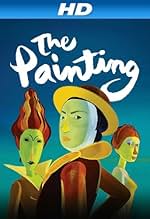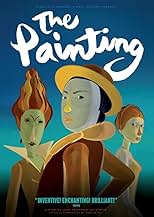AVALIAÇÃO DA IMDb
7,3/10
4,7 mil
SUA AVALIAÇÃO
Três personagens de diferentes classes sociais fogem de seu quadro inacabado em busca do Pintor, esperando que ele o conclua.Três personagens de diferentes classes sociais fogem de seu quadro inacabado em busca do Pintor, esperando que ele o conclua.Três personagens de diferentes classes sociais fogem de seu quadro inacabado em busca do Pintor, esperando que ele o conclua.
- Direção
- Roteiristas
- Artistas
- Prêmios
- 2 vitórias e 3 indicações no total
JB Blanc
- The Painter
- (English version)
- (narração)
- …
Steve Blum
- Self-Portrait
- (English version)
- (narração)
Colin DePaula
- Gum
- (English version)
- (narração)
Wayne Grayson
- Quill
- (English version)
- (narração)
- (as Vinnie Penna)
Jason Griffith
- Additional Voice
- (English version)
- (narração)
Christopher Kromer
- Gray Morgen
- (English version)
- (narração)
Mary Elizabeth McGlynn
- Florence
- (English version)
- (narração)
Kamali Minter
- Lola
- (English version)
- (narração)
Dave B. Mitchell
- Pierrot
- (English version)
- (narração)
- …
Avaliações em destaque
It's a been a while since a film has filled me with wonder. The idea and visual effects created a world that makes you wish you could crawl through your TV. Every aspect of this movie soars: dialogue, character, story, visual, tone, etc. By comparison, the American animated movies seem too safe and predictable.
The visual team did an excellent job of creating a painted world in terms of how it looked and functioned. Some very clever thinking went into deciding what's possible within a canvas. The plot was straight forward, the painted characters fear they have been abandoned, but has enough substance for serious introspection.
The Painting is an excellent film for children and adults. It tackles some more serious themes than most American cartoons: racism, death, and philosophical questions about our purpose and creation. I'll be looking forward to seeing more films by the highly imaginative director Jean- Francois Laguionie.
The visual team did an excellent job of creating a painted world in terms of how it looked and functioned. Some very clever thinking went into deciding what's possible within a canvas. The plot was straight forward, the painted characters fear they have been abandoned, but has enough substance for serious introspection.
The Painting is an excellent film for children and adults. It tackles some more serious themes than most American cartoons: racism, death, and philosophical questions about our purpose and creation. I'll be looking forward to seeing more films by the highly imaginative director Jean- Francois Laguionie.
The Painting is not a film for everyone. Despite being an animated film, this French film is definitely not designed for kids. And, it's also not for everyone else—just folks who can admire its artistry and style. As I sat and watched this one with my daughter, she clearly became bored with the film—though she admitted that the film was visually stunning. As for me, I could agree that the film has slow moments, but it's one you need to keep watching, as it becomes more and more spectacular as you watch.
The film begins within a painting where all the characters in the painting are alive and there is its own little world. It's also a highly prejudiced world and there is a clear caste system. At the top are the Alldunns—characters who are completely painting by the artist. They feel superior and look down on the others. Next come the Halfies— those who are painted but who have not had all their colors applied. And, at the bottom, come the Sketchies—primitive sketches and nothing more. Within this world is a problem, as an Alldunn has fallen in love with a Halfie—and his fellow Alldunns are NOT pleased! So what are the young lovers to do? Yep they're going in search of the artist himself to get him to finish the painting and make everyone equal! Along the way, the girl gets lost but her boyfriend continues the trip—along with a very brave Halfie girl and a poor Sketchie. While this all sounds very weird, it does get weirder. Eventually, the trio manage to get to the edge of the painting and then they pass through it to the outside world. They find themselves in the artist's studio. He isn't there but many of his paintings are. Amazingly, they find that they can enter these paintings as well—and soon they make friends with a young soldier named Magenta. What's next? See the film—it is rather amazing.
The first 15 or so minutes of the film is stuck on the original painting. It is a rather garish land—much like a Gaugin painting. Most of the characters weren't very interesting, the colors are garish and I wish that less time had been spent here. However, I urge you to sit tight and keep watching! The other paintings often have a different look (such as Modigliani and Cocteau)—as if they were done by an artist trying various styles. Some of these are quite arresting—as it is seeing the characters from the paintings walking in both a CG world (the studio) as well as into the real world itself at the very end! Additionally, because the film is made by using computer graphics, they are able to achieve a wonderful 3D look that is completely unique. Sure, some of Aleksandr Petrov's shorts are prettier when it comes to the paintings (especially since Petrov does it without computers), but he couldn't achieve exactly the same sort of look and style—nor could he bring the real world into the computer graphics world.
So did I adore the film? No. I agree with my oldest daughter that the film does have some slow moments and forgettable characters. It also might improve if it was a bit shorter and tighter. But, I still recommend you see it because it is so unique and clever. It's a film for anyone wanting something different or who has a love of both animation and art films.
The film begins within a painting where all the characters in the painting are alive and there is its own little world. It's also a highly prejudiced world and there is a clear caste system. At the top are the Alldunns—characters who are completely painting by the artist. They feel superior and look down on the others. Next come the Halfies— those who are painted but who have not had all their colors applied. And, at the bottom, come the Sketchies—primitive sketches and nothing more. Within this world is a problem, as an Alldunn has fallen in love with a Halfie—and his fellow Alldunns are NOT pleased! So what are the young lovers to do? Yep they're going in search of the artist himself to get him to finish the painting and make everyone equal! Along the way, the girl gets lost but her boyfriend continues the trip—along with a very brave Halfie girl and a poor Sketchie. While this all sounds very weird, it does get weirder. Eventually, the trio manage to get to the edge of the painting and then they pass through it to the outside world. They find themselves in the artist's studio. He isn't there but many of his paintings are. Amazingly, they find that they can enter these paintings as well—and soon they make friends with a young soldier named Magenta. What's next? See the film—it is rather amazing.
The first 15 or so minutes of the film is stuck on the original painting. It is a rather garish land—much like a Gaugin painting. Most of the characters weren't very interesting, the colors are garish and I wish that less time had been spent here. However, I urge you to sit tight and keep watching! The other paintings often have a different look (such as Modigliani and Cocteau)—as if they were done by an artist trying various styles. Some of these are quite arresting—as it is seeing the characters from the paintings walking in both a CG world (the studio) as well as into the real world itself at the very end! Additionally, because the film is made by using computer graphics, they are able to achieve a wonderful 3D look that is completely unique. Sure, some of Aleksandr Petrov's shorts are prettier when it comes to the paintings (especially since Petrov does it without computers), but he couldn't achieve exactly the same sort of look and style—nor could he bring the real world into the computer graphics world.
So did I adore the film? No. I agree with my oldest daughter that the film does have some slow moments and forgettable characters. It also might improve if it was a bit shorter and tighter. But, I still recommend you see it because it is so unique and clever. It's a film for anyone wanting something different or who has a love of both animation and art films.
The Painting (2011)
If you like animated films in general, and like inventive ones in particular, see this. I think it's good on many levels—the story, the style, the feeling. Even the sentimental ending.
But my taste for animation varies wildly. I loved "Monsters, Inc." and hated "Pocahontas." Anime leaves me cold. It isn't enough to dazzle me with animation tricks, nor to play with children's stories in inventive ways on screen.
So this story works with lots of familiar (too familiar) tropes—types of friends, heroes, problems that we know well. The animation (French) is different than both Pixar and Disney styles we know well, and also different than, say Wallace and Gromit (which wasn't American). But it isn't self-sustaining. I mean, it's a little constrained and polite, even when it is taking visual chances. It's all very "nice" all the time, and that goes with the friendly quality of the movie, too.
I sound like a curmudgeon. Not so (I think)! But I tried and tried to get absorbed and just got, well, bored. Sad to say. Judge for yourself. I will say that I think you need to give it a half an hour or so to get into some of the range of the film. But then, if it hasn't hooked you, it probably won't.
If you like animated films in general, and like inventive ones in particular, see this. I think it's good on many levels—the story, the style, the feeling. Even the sentimental ending.
But my taste for animation varies wildly. I loved "Monsters, Inc." and hated "Pocahontas." Anime leaves me cold. It isn't enough to dazzle me with animation tricks, nor to play with children's stories in inventive ways on screen.
So this story works with lots of familiar (too familiar) tropes—types of friends, heroes, problems that we know well. The animation (French) is different than both Pixar and Disney styles we know well, and also different than, say Wallace and Gromit (which wasn't American). But it isn't self-sustaining. I mean, it's a little constrained and polite, even when it is taking visual chances. It's all very "nice" all the time, and that goes with the friendly quality of the movie, too.
I sound like a curmudgeon. Not so (I think)! But I tried and tried to get absorbed and just got, well, bored. Sad to say. Judge for yourself. I will say that I think you need to give it a half an hour or so to get into some of the range of the film. But then, if it hasn't hooked you, it probably won't.
This animated movie is a good surprise.
With an innovative setting - a painting, it is filled with the intention to speak about art and creation. The animation by itself area celebration of the old handmade classics vs the new 3D-computerized trend. It reminds me a bit of "Le roi et l'oiseau" in some ways. Plus, of course, a few well-known painters through different figures.
That common theme, art and creation, is kept intellegently the whole movie - thanks to the painting first and then the search of the painter, and, thus, the meaning of a piece and its future.
Fortunately, the movie doesn't stop there and adds a layer for the adults in depicting a layer society - here based on the care you were getting from the painter - not too far from ours.
Finally, there is adventure, that makes it a movie for everyone.
Not everything is perfect though and I do agree with some reviewers pointing some weak moments (I would also have loved some "Alice in Wonderland" crazyness) and weak characters that pales in front of their quest. Would have ended it before too.
But these weaknesses are not that big they will prevent you enjoying this movie.
Not everything is perfect though and I do agree with some reviewers pointing some weak moments (I would also have loved some "Alice in Wonderland" crazyness) and weak characters that pales in front of their quest. Would have ended it before too.
But these weaknesses are not that big they will prevent you enjoying this movie.
This is a very earnest but fun film which uses paintings to make a compelling, if also fairly vague, social statement. I got it because I was intrigued by the connections it would make between paintings and animation, and thought my kids would find this interesting. I later realized that the film's main premise, that paintings are "alive" like animation, and can even escape their canvas, was actually not new, but lifted directly from The King and the Mockingbird-a dependence which is not surprising given that The Painting was produced in France and Belgium. While that film used paintings to comment on the medium of animation, The Painting delves deeper into the painting itself, which it uses as an allegory for society. One premise is that paintings are a snapshot of an active world, which is moving behind the scenes; the other is that paintings are strictly hierarchical: some characters are fully colored ("all dones"); others are still in need of some coloring ("halfies"); and, at the bottom, are the mere sketches. The idea is that the painting is unfinished, but one could equally imagine that certain layers/characters have been abandoned and overpainted. The movie is, at its heart, a morality tale speaking out against the abuse of power by some of the "all dones," especially against the sketches, which could be applied to many situations; the idea that the halfies and sketches efforts to find the painter to complete themselves is misguided sends a much more ambiguous and mixed message. In any case, my kiddos enjoyed it and talked about it a lot afterwards.
Você sabia?
- CuriosidadesThe graphic style of the animation references several French painters, among which Henri Matisse, André Derain and Pierre Bonnard.
Principais escolhas
Faça login para avaliar e ver a lista de recomendações personalizadas
- How long is The Painting?Fornecido pela Alexa
Detalhes
- Data de lançamento
- Países de origem
- Central de atendimento oficial
- Idioma
- Também conhecido como
- The Painting
- Empresas de produção
- Consulte mais créditos da empresa na IMDbPro
Bilheteria
- Faturamento bruto nos EUA e Canadá
- US$ 21.008
- Fim de semana de estreia nos EUA e Canadá
- US$ 3.626
- 12 de mai. de 2013
- Faturamento bruto mundial
- US$ 22.313
- Tempo de duração1 hora 20 minutos
- Cor
- Mixagem de som
- Proporção
- 1.85 : 1
Contribua para esta página
Sugerir uma alteração ou adicionar conteúdo ausente


![Assistir a Bande-annonce [OV]](https://m.media-amazon.com/images/M/MV5BM2ZhMWM4ZDctNTc2OS00MTBmLTg5NGItNzUzMGFhZjQzZmJmXkEyXkFqcGdeQXRyYW5zY29kZS13b3JrZmxvdw@@._V1_QL75_UX500_CR0)
